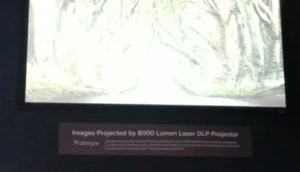AstroDesign, working with NHK, was showing a real time MTF (Modulation Transfer Function) measurement using the knife-edge technique. To demonstrate this, an 8K camera was imaging a test pattern that is then processed and displayed as an MTF response curve. The curve moves as the camera’s zoom, focus and aperture are adjusted. This can be very useful for quality control or R&D purposes for quickly assessing the quality of a lens.
Canon was showing their new 2000 cd/m² (with a 100% white patch) 4K 30” reference monitor. It is available now for $50K (although it told us at IBC that it is only available to special order Canon Adds More HDR Support). The company does not disclose the number of LED in the direct backlight nor the exact chromaticities of the display, but “very close to BT.2020” was the only response we got, plus the fact that it does cover 100% of DCI-P3.
They also showed a 600 cd/m² reference monitor in a 24” form factor. They think the vast majority of HDR grading can be done on a monitor like this as most content is below 600 cd/m² . If you want to check the highlights, you can boost the luminance to 1000 cd/m² , with the trade off that this raises the blacks. However, this is a feature that is likely to indeed be popular.
Canon demonstrated a nice feature as well: applying grayscale and color coding to the image based on the luminance of each pixel. For example, any pixel with luminance below 100 cd/m² (SDR) showed up as a grayscale image. This showed just how much of most images are still in the SDR luminance range. It also highlights the brightest pixels quite well with the observation that not much of the picture is above 1000 cd/m² either.
TV Logic was showing their 2000 cd/m² grading 31” monitor which is based on a single LCD panel and backlight display supplied by Panasonic. Luminance range is 0.002 to 2000 cd/m² . 2040 white LEDs are in the backlight which delivers 87% coverage of BT.2020 and 100% coverage of DCI-P3. It is available now for $43K. TV Logic also offers an 850 cd/m² 31” 4K grading monitor.

We asked who wants to grade at 2000 cd/m² and they said companies like Netflix and Amazon have been asking for it. Does that mean these companies will soon require grades at 2000 cd/m² ? We will see.
Flanders Scientific Inc. (FSI) was showing two monitors that were shown at IBC (Flanders Scientific Have OLED & 2K HDR LCD Monitor). One was their version of the 2000 cd/m² 31” monitor with the Panasonic display. They claim it only reaches 900 cd/m² with a 100% white screen, but can reach 2300 cd/m² with a 20% white patch. Their display will cost $45K and should ship in Q1’18.
They also highlighted their new 55” OLED monitor, which they say is only to be used as a review, not grading monitor. It will cost $12-$15K and include a 12G-SDI interface.(in and out), DP 1.2 and a 3G-SDI output for an HD monitor.
Eizo was showing the CG3145 monitor which is 1000 cd/m² and uses the dual modulation panel/BLU display also from Panasonic. It was shown at IBC (Eizo Planning CG3145 High Contrast Monitor Shipment).
Dolby Labs was showing the advantage of encoding the video signal using ICtCp as opposed to YCbCr. With YCbCr, Dolby contends you can get color noise from the Y luminance channel, which was being demonstrated (hard to see red noise, but blue was quite obvious). They then showed the same images encoded with ICtCp and the noise went away. – CC



